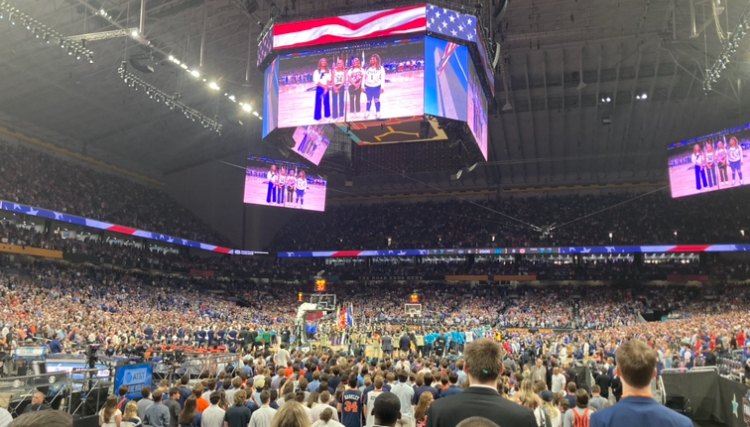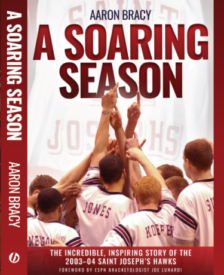
The view from my press row seat prior to tipoff at the Final Four last spring in San Antonio. Can a Big 5 team make March Madness this season and end a three-year drought? (Photo: Aaron Bracy/Big5Hoops)
By AARON BRACY
October 31, 2025
Big5Hoops.com
The Big 5 has gone three consecutive seasons without a team in the NCAA tournament. On paper, the chances of the sad streak ending this season do not look great. However, the games, as we know, are not played on paper.
Every team in the city will have its chance to prove prognosticators wrong when the season tips off for the locals on Monday night with Widener at Drexel at 6 p.m., Saint Joseph’s hosting Lafayette at 7, and Villanova facing BYU in Las Vegas at 9:30.

Sponsored
Click HERE to order a signed copy of my book, A Soaring Season: The Incredible, Inspiring Story of the 2003-04 Saint Joseph’s Hawks.
Here is the predicted order of conference finish for each of the Big 5 teams in the official preseason polls:
Drexel: 10 of 13 in the Coastal Athletic Association
La Salle: 13 of 14 in the Atlantic 10
Penn: 7 of 8 in the Ivy League
Saint Joseph’s: 7 of 14 in the Atlantic 10
Temple: 9 of 13 in The American
Villanova: 7 of 11 in the Big East
—
Here’s the preseason KenPom rankings for each, in order from best to worst:
Villanova: 50
Saint Joseph’s: 109
Temple: 131
La Salle: 201
Drexel: 238
Penn: 276
—
These numbers do not exactly inspire confidence in the Big 5’s chances to reach the Big Dance. So, which teams have the best shot? And what will need to happen for each to make the NCAA tournament? Outside of Villanova, which has a schedule conducive to an at-large selection, the other five Big 5 teams will need to win their conference tournaments to earn the right to play in March Madness.
Here is my list, in order from best chance to worst chance, of making the NCAA tournament and analysis:
–Penn: The Quakers topping my list might surprise you, but there are several factors which have them here for me. First, the Ivy League has just eight teams so the mathematical possibility is greater. There’s that. More than that, though, the Quakers have a legitimate first-team Ivy player in Ethan Roberts, who averaged 16.8 points and 5.6 rebounds while starting all 25 games last season in his first season at Penn. Look for the 6-foot-5 senior to elevate his game under first-year coach Fran McCaffery. Virginia transfer T.J. Power is a former five-star recruit who played the last two seasons at Duke and Virginia and should excel at the Ivy level. And McCaffery, the Penn alum and lover of the Big 5 and the Palestra with all of that Power 5 coaching experience at Iowa and unique, up-tempo style, gives the Quakers as good as any coach in the league. The Ivy League is top-heavy, with Yale, Cornell, and Harvard likely locks for Ivy Madness, the league’s four-team tournament to determine the NCAA representative. If Roberts plays well and Power is healthy and Penn quickly adapts to McCaffery’s style, the Quakers could sneak into the No. 4 spot in the league. After that, as they say, anything is possible.
–Saint Joseph’s: Entering last season, the Hawks were considered Atlantic 10 contenders and a potential NCAA team. They finished with 22 wins and a second straight Big 5 title, but home nonconference losses to Central Connecticut, Princeton, and Charleston crushed any chances of an at-large selection. A so-so, 11-7 mark in the league’s regular season didn’t portend a tournament title, and the Hawks bowed out in the A-10 semis for the second straight year. Expectations seem to be lower this season although the talent level, I’d argue, is better. Deuce Jones, the La Salle transfer and reigning A-10 Rookie of the Year, is one of the best players in the league. St. John’s transfer Jaiden Glover-Toscano has looked great in the preseason. The Hawks have solid, experienced Atlantic 10 players with Derek Simpson, Anthony Finkley, Dasear Haskins, and Justice Ajogbor. The September resignation of Billy Lange was jarring to players at first, but Steve Donahue has embraced his role after being elevated from assistant coach. Donahue’s struggles at Penn of late related largely to recruiting. On Hawk Hill, he has talent to work with; in fact, he said on a recent appearance on the Hawk Talk Podcast that it’s the most athletic team he’s ever coached, including his time in the ACC at the helm of Boston College. Whether Donahue can recruit to St. Joe’s is a discussion for another day, but I have a sneaky feeling that he will be successful with the pieces Lange has left him while playing a style that will rely less on finicky three-point shooting and more on cutting, driving, and defending. The schedule is not good enough for an at-large bid, but keep your eyes on the Hawks at the conference tournament in March in Pittsburgh.
–Villanova: There is renewed hope at Villanova that Kevin Willard can resurrect the program that Jay Wright made a national power. It will be interesting to see if Willard gets some leeway that Kyle Neptune never really received. (I think he will.) Preseason injuries to veteran guard Devin Askew and Temple transfer Zion Stanford are not great for Willard and the Wildcats. Askew should be back in time for the Wildcats’ home games next weekend while Stanford could miss another month. Freshman Acaden Lewis has received raves for his play in the preseason. Overall, though, Villanova is relying on players who are stepping up in class, such as Bryce Lindsay, who excelled at JMU last season by draining 87 three-pointers; who had limited roles at big-time programs, such as Malachi Palmer, who came to Villanova with Willard from Maryland; or first-year players, like Lewis, who have talent but not experience. (Tyler Perkins, the Penn transfer who averaged 6.3 points and 4.3 rebounds last season for the Wildcats gives Villanova a solid, proven Big East player.) The Wildcats also have a really tough schedule, with Monday’s opener at BYU starting the gauntlet that includes games at Michigan, on a neutral court (in Milwaukee) versus Wisconsin, and home versus Pitt, to name a few. So, there are opportunities, but they won’t be easy. The Big East, as usual, will be tough. Willard’s track record says that Villanova will get back to the tournament and, probably, back to making deep runs there. But it would be surprising if either happened this season.
–Drexel: The transfer portal was not kind to the Dragons, but it also was a testament to the success and player development of coach Zach Spiker and his staff. Yame Butler (Butler), Jason “Deuce” Drake (Indiana), Cole Hargrove (Providence), and Kobe MaGee (Florida State) all went on to bigger programs—and bigger paydays—after having success at Drexel last season. Shane Blakeney (7.5 points and 3.5 rebounds last season) and Garfield Turner (5.1 points and 4.6 rebounds in 2023-24), if healthy, give the Dragons a pair of high-end CAA players. After that, there is a lot of potential, from those who have been in the program and others who have transferred in, that Spiker and Company will need to mold. I can’t imagine Drexel finishing 10th, as predicted, (or lower) in the league. But it’s a tough mid-major conference and the Dragons have their work cut out for them to cut down the nets in Washington, D.C. in March at the CAA tourney. Let’s see how the players develop during the course of the season, of course. For now, though, it’s a long shot. With Spiker’s track record, give the Dragons a puncher’s chance.
–Temple: If things could go wrong for Temple last season, they did. From injuries to suspensions to departures, the Owls never were able to put the team on the floor that coach Adam Fisher envisioned prior to the season. That team would have been really good and probably had Temple as a contender for The American title. But the Owls were just mediocre. Fisher has brought in some talent, notably intriguing Arkansas State transfer Derrian Ford, and has solid pieces to build around in sophomores Aiden Tobiason and Babatunde Durodola. But the Owls were picked near the bottom of the league at ninth of 13 teams for a reason. This could be a pretty good Temple team, one that reaches 20 wins. But a berth in the NIT is probably more realistic than a trip to March Madness.
–La Salle: First-year coach Darris Nichols and his staff have brought a youthful enthusiasm and renewed energy to the Explorers program. It has been great to see. Nichols’ style of play is interesting, with a huge emphasis on offensive rebounding and free-throw shooting while playing a rotation of 10-plus players. La Salle could give teams headaches, and I would expect the Explorers to pull off some upsets this season. They have some interesting prospects, none more so than Texas A&M transfer Rob Dockery, whose two-year tenure in College Station did not work out despite his high prospects coming out of the talent-rich DMV. All of that said, it is a really long way to go from being picked one spot from the bottom of the A-10 to winning the conference title. A successful season for Nichols and the Explorers will be getting to the middle of the conference and building on that with a strong recruiting class, through high school and the portal, for next season. Then, let’s circle back to this NCAA conversation.
—
You can listen to these thoughts on Episode 54 of the Bracy Sports Media Podcast, which is available on Apple, Spotify, or the Bracy Sports Media YouTube channel below:
—
Aaron Bracy has covered sports in Philadelphia for nearly three decades for various publications and as a freelancer for the Associated Press. His first book, A Soaring Season: The Incredible, Inspiring Story of the 2003–04 Saint Joseph’s Hawks (Brookline), can be ordered HERE. He is working on his second book, which will chronicle the memorable 2000–01 season of Allen Iverson and the Philadelphia 76ers. It will be published in April 2027. Follow Bracy on social media HERE. Contact him at bracymedia@gmail.com.